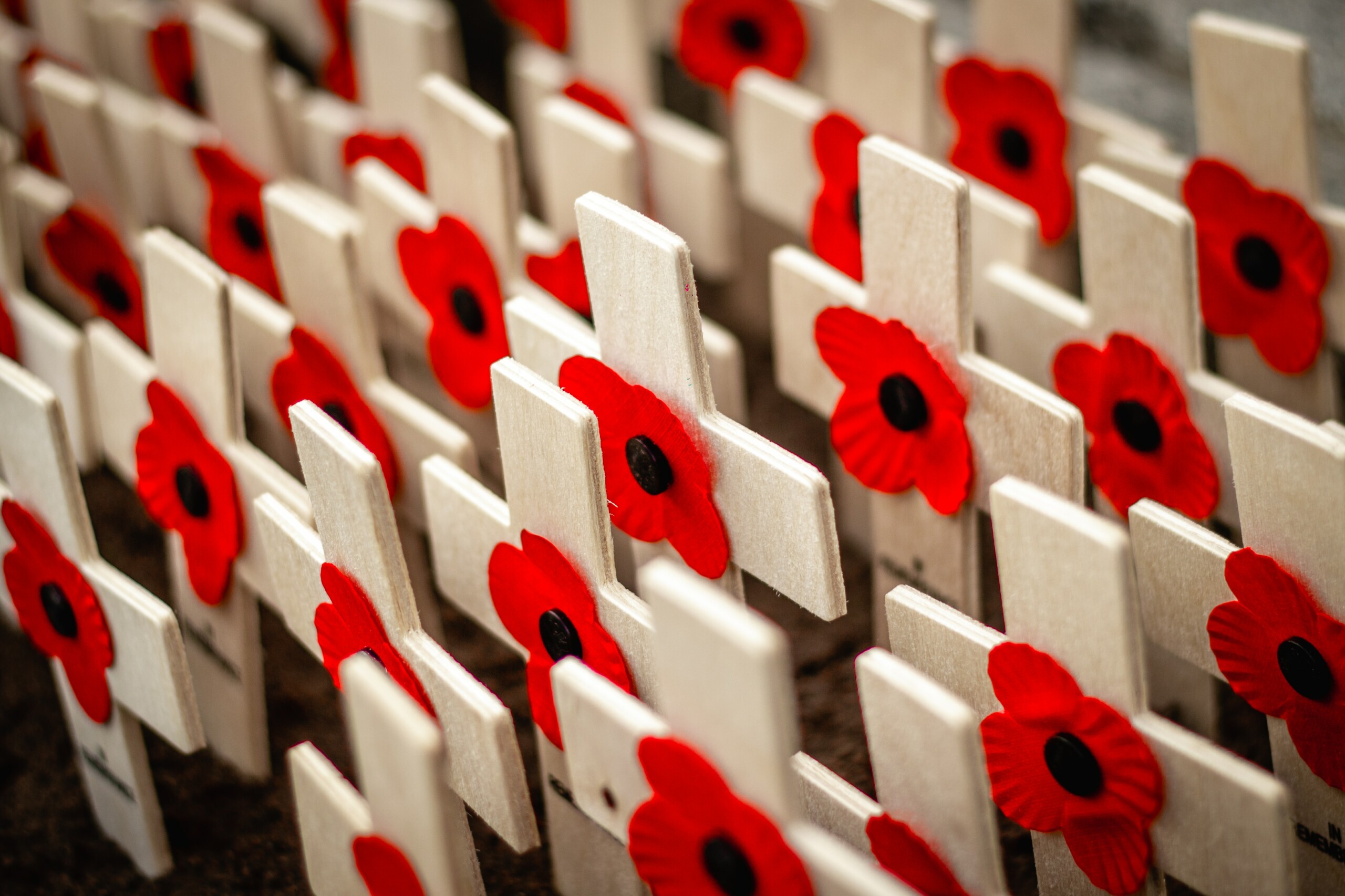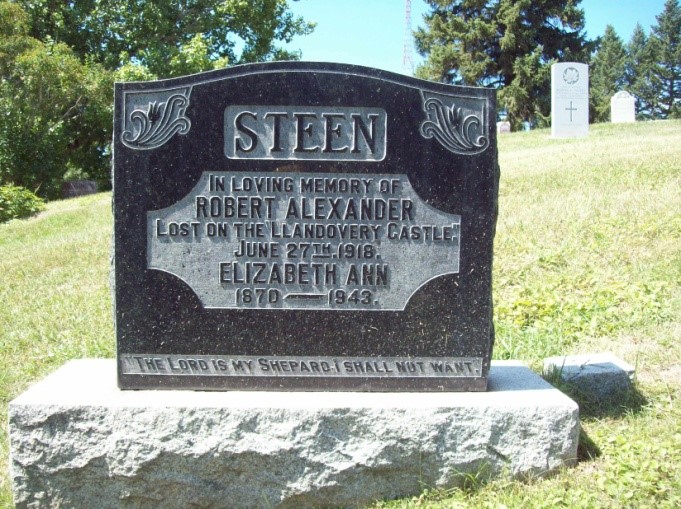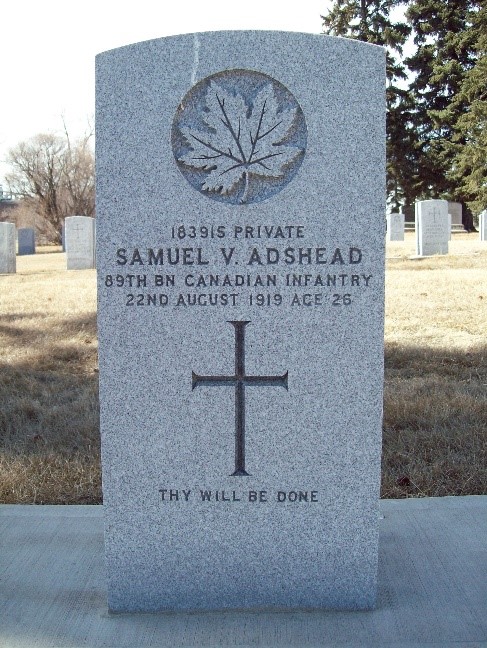War Crimes

Photo by Chris Sansbury
Samuel Vernon Adshead was born in Madoc, Hastings, Ontario but moved, with his family as a child, to Calgary. His father, Herbert Bealey Adshead, served for two single-year terms as a city alderman, His mother was Helen, known as Nellie, Adshead. Adshead also had an older brother, Harry Percy.
Harry enlisted to serve with the Canadian Expeditionary Force (C.E.F.) on December 24, 1914 and served with 10th Battalion. He was killed in battle on March 9, 1915 at 24 years old during the launch of the first major Allied offensive at Neuve-Chapelle. While this was a British campaign, the C.E.F. held the next sector and supported the attack with small arms and artillery fire. As a result, the Canadian trenches were subject to German artillery fire, which caused Harry’s death.
Samuel worked as a plasterer before enlisted in the C.E.F. on October 23, 1915, the day before his 22 birthday and less than 6 months after his brother’s death. He went overseas and serve with the 89th Battalion. During his time there, he met and married Elizabeth.
Samuel was served in France where he caught mumps in March of 1917. This developed into masses in his left hip and shoulder that required hospitalization. Upon his discharge, Samuel was reassigned to the 1st Signals Base, East Sandling, England. In June 1918 it was discovered that he had developed tuberculosis (called phthisis at the time) and he was discharged to Canada as medically unfit.
Samuel returned to Canada on the His Majesty’s Hospital Ship (HMHS) Llandovery Castle, arriving in Halifax on June 17, 1918. Adshead was hospitalized in Calgary until his death from tuberculosis on August 22, 1919, He was 26 years old.
The HMHS (formerly Royal Mail Ship [RMS]) Llandovery Castle was one of a pair of ships build for the Royal Mail Line in 1912. Originally sailing routes between London and Africa, the Llandovery Castle was commissioned as a hospital ship on July 26, 1916 and assigned to the C.E.F. in March of 1918. She had over 600 beds and carried a medical staff of 102.
As per the rules of war in regard to hospital ships, the HMHS Llandovery Castle was painted white with large red crosses on her smoke stacks. She traveled outside of convoys and remained fully lit at night. These precautions were supposed to keep her safe on her journeys across the Atlantic.
After her June 1918 crossing with a shipload of wounded Canadian soldiers, including Private Samuel Adshead, the HMHS Llandovery Castle was sent back to England with a compliment of Canadian Army Medical Corps (CAMC) personnel, including 14 nursing sisters.
On June 27, 1918, against international law and the standing orders of the Imperial German Navy, the submarine U-86 launched a torpedo attack on the HMHS Llandovery Castle. The two torpedoes struck her midship, breaking the HMHS Llandovery Castle in two. The back half, which contained the engine room, continued at full speed, forcing the front half of the ship underwater before sinking itself.
There was little time to react before the ship was gone and few lifeboats were launched. After the HMHS Llandovery Castle had disappeared beneath the waves, the U-boat surfaced and attempted to make the survivors say that the ship had been carrying ammunition, which would have made her a legitimate target.
When that failed, Captain Helmut Brummer-Patzig and his first and second officers, Ludwig Dithmar and John Boldt sent the crew below deck. The three men then machine-gunned the lifeboats before fleeing the scene. They even went so far as to swear the crew to secrecy and alter the U-boat’s log to make it look like they were not in the area.

Thirty-six hours later, the British destroyer, HMS Lysander, rescued the 24 survivors and the story came out. Of the 258 people on board, only twenty-four survived, six of whom were members of the CAMC. Among the dead were the fourteen nursing sisters. They were:
- Matron Margaret Marjory (Pearl) Fraser
- Carola Josephine Douglas
- Alexina Dussault
- Minnie Aenath Follette
- Margaret Jane Fortescue
- Minnie Katherine Gallaher
- Jessie Mabel McDiarmid
- Mary Agnes McKenzie
- Christina Campbell
- Rena McLean
- Mary Belle Sampson
- Gladys Irene Sare
- Anna Irene Stamers
- Jean Templeman
Also killed during the sinking of the HMHS Llandovery Castle was Private Robert Alexander Steen. Born in Chatham, ON, Robert enlisted on May 1, 1915, and served overseas in clearing stations before being assigned to the ship. He was declared missing, presumed dead and his body was never recovered. Robert is commemorated on Panel 2 of the Halifax Memorial. Robert, who was 47 at the time of his death, left behind a wife, Elizabeth Ann, and two daughters, Leta and Elizabeth (Betty). Elizabeth would remember her husband on her headstone when she died 24 years later.
The sinking of the HMHS Llandovery Castle caused outrage at the time and is still considered one of the worst atrocities of the Great War. It is said that during the last 100 days of the war, when the Allied began to take back the ground lost to the Germans, “Remember the Llandovery Castle” was a Canadian battle cry. An image of the event was used to sell Victory Bonds.
After the armistice was signed, Canada insisted Great Britain prosecute the three senior officers of U-86 for war crimes. This was done through the German courts. Oberleutnants Ludwig Dithmar and John Boldt were found guilty on June 21, 1921 and sentenced to four years in prison. The guilty verdicts were later overturned, as it was determined that they were just following orders. Kapitanleutnant Helmut Brummer-Patzig managed to flee to Danzig, a free city after the Great War, and was never prosecuted. All three were later exonerated by the Nazi government of Adolf Hitler.
In Canada, the story of the HMHS Llandovery Castle sadly faded from collective memory and today few of us have heard of her or the terrible loss of Canadian lives.

